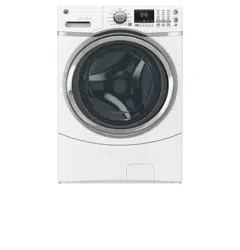Documents: Go to download!
User Manual
- Owner's manual - (English, French, Spanish)
- Quick Specs - (English)
- Using the washer
- Care and Cleaning
- Troubleshooting Tips
Table of contents
USER MANUAL Washer
Using the washer
Getting Started
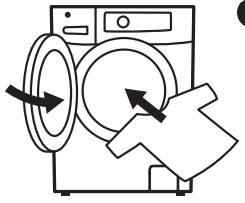 | 1.Load clothes into your washer and close the door. |
 | 2. Press Power to turn on the washer. |
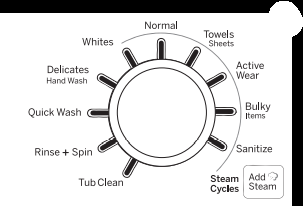 (cycle options vary by model) | 3. Turn the knob to the desired cycle or use My Cycle (on some models) to program or recall your favorite cycle. 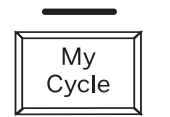 |
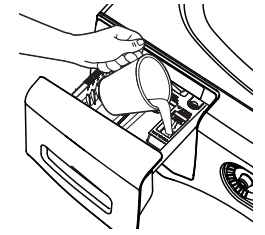 | 4. Open the dispenser and add detergent, bleach and fabric softener, as desired. |
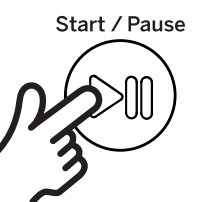 (appearance will vary) | 5. Press Start to begin the wash cycle. The machine will weigh your clothes and add the proper amount of water. When the wash cycle is finished, the door will unlock. |
Controls
You can locate your model number on a label on the side of the washer or inside the washer door.
Models: GFW450, GFWS1700, GFWS1705 and GFWN1600 (features vary by model)
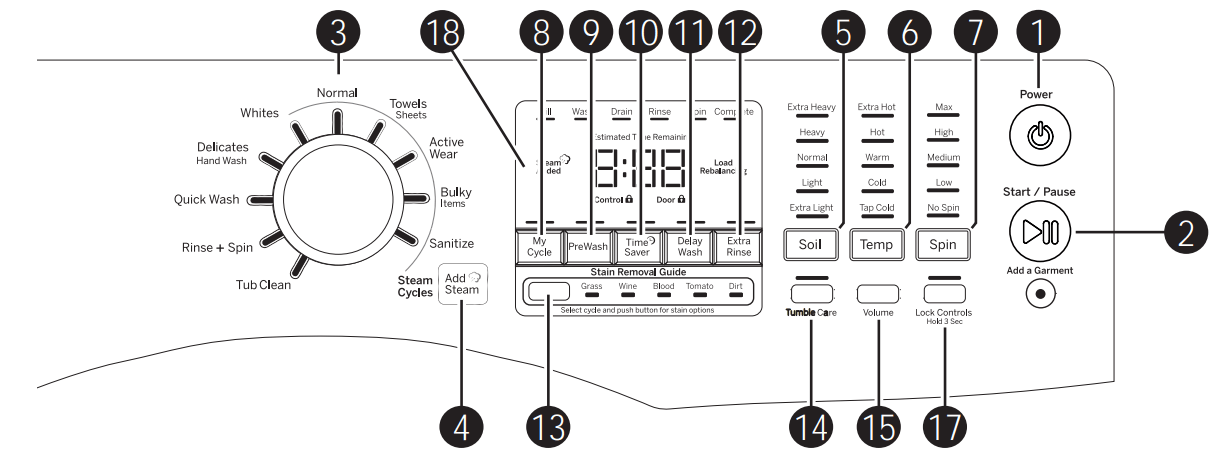
1.Power
Press to “wake up” the display. If the display is active, press to put the washer into standby mode. NOTE: Pressing Power does not disconnect the appliance from the power supply.
2. Start/Pause-Add A Garment
Press to start a wash cycle. If the washer is running, pressing it once will pause the washer and unlock the door. It will take a few seconds for the door to unlock after pressing Pause. Press again to restart the wash cycle.
NOTE: If the washer is paused and the cycle is not restarted within 15 minutes, the current wash cycle will be cancelled.
NOTE: In some cycles the washer will drain first, then unlock the door when it is paused.
NOTE: The washer performs automatic system checks after pressing the Start button. Water will flow in 45 seconds or less.
You may hear the door lock and unlock before water flows; this is normal.
3. Wash Cycles
The wash cycles are optimized for specific types of wash loads.
The chart below will help you match the items to be washed with the best wash cycle settings. For optimal performance, select the cycle that most closely matches the items being washed.
Selections and options shown in bold are the suggested settings for that cycle.
*Some cycles and options may not be available on some models
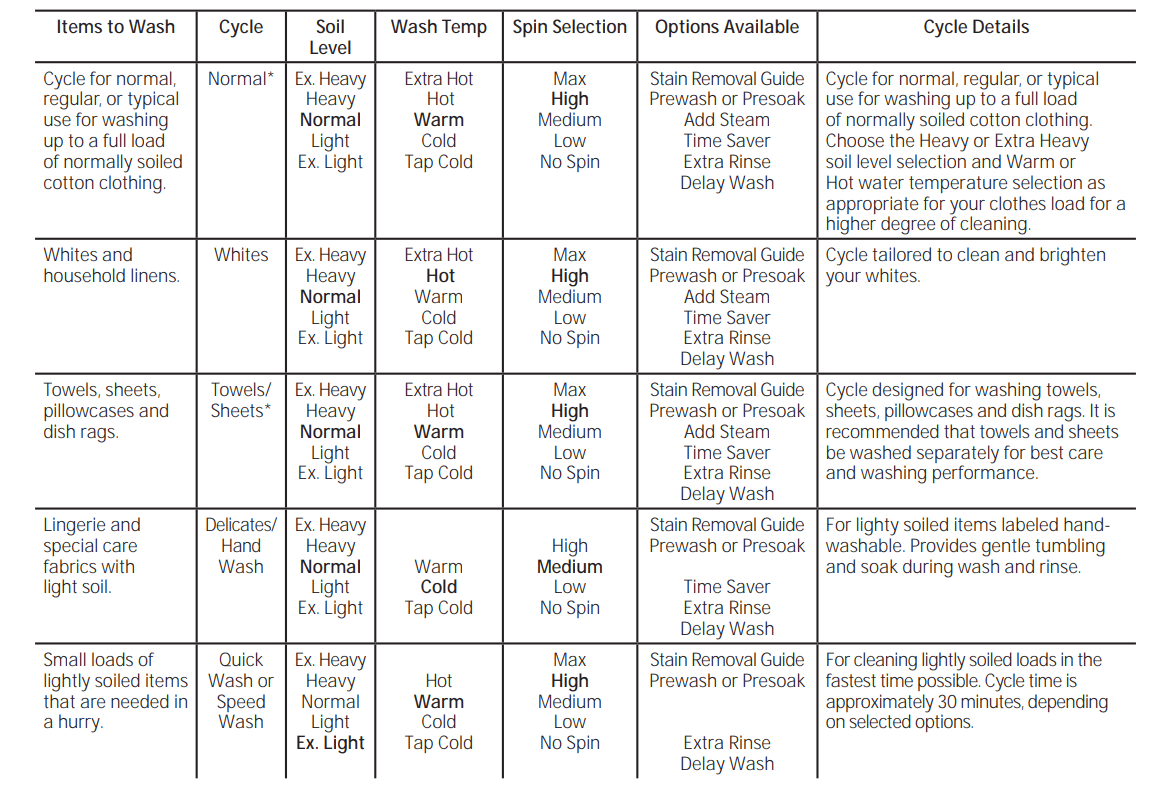

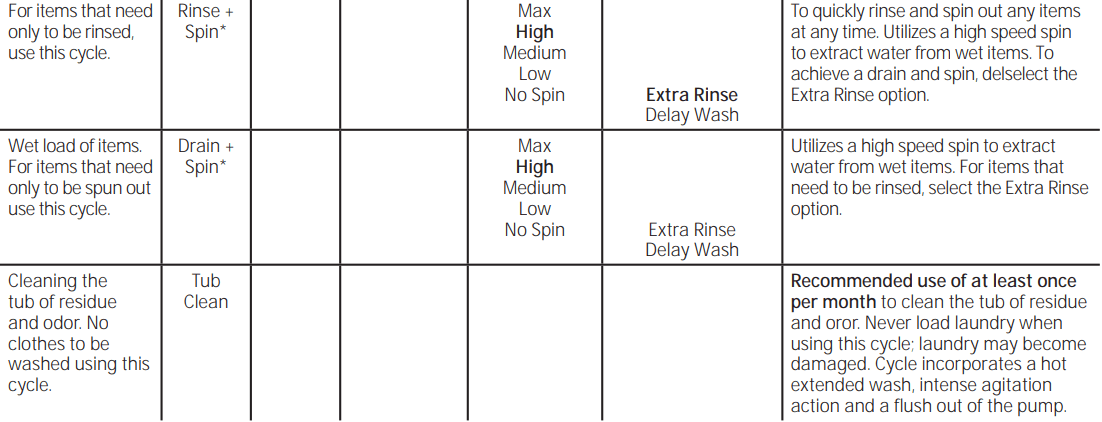
4.
 | Add Steam (on some models) Add Steam adds steam into the washer to assist with loosening stains on the Whites, Colors/Normal, Towels/Sheets, Active Wear, Bulky Items or Sanitize cycles. | To use:
|
5.
 (appearance will vary) | Soil Change the Soil level to increase or decrease the wash time to remove different amounts of soil. | To change the Soil level, press the Soil level button until you have reached the desired setting. You can choose between Extra Light, Light, Normal, Heavy or Extra Heavy soil levels. |
6.
 (appearance will vary) | Temp Adjust to select the proper main water temperature for the wash cycle. The PreWash rinse water is always cold to help reduce energy usage and reduce setting of stains and wrinkles. Follow the fabric manufacturer’s care label when selecting the wash temperature. To change the wash temperature, press the wash Temp button until you have reached the desired setting. You can choose | between Tap Cold, Cold, Warm, Hot or Extra Hot (Extra Hot is available on some models). By design, to protect fabrics, not all wash temperatures are available for certain wash cycles. NOTE: The first 10 seconds of the wash fill is always cold. This feature assists in conditioning the fabric and preventing stains from setting on garments. |
7.
 (appearance will vary) | Spin Changing the Spin speed changes the final spin speed of the cycles. Always follow the garment manufacturer’s care label when changing the Spin speed. To change the Spin speed, press the Spin speed button until you have reached the desired setting. You can choose between No | Spin, Low, Medium, High or Max. Higher spin speeds are not available on certain cycles, such as Delicates. Higher spin speeds remove more water from the clothes and will help reduce dry time, but may also increase the possibility of setting wrinkles on some fabrics. |
8.
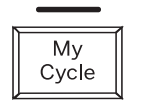 | My Cycle (on some models) To save a favorite cycle, set the desired settings for wash cycle, soil level, spin speed and wash temp settings and hold down the My Cycle button for 3 seconds. A beep will sound to indicate the cycle has been saved. To use your custom cycle, press the My Cycle button before washing a load. To change the saved cycle, set the desired settings and hold down the My Cycle button for 3 seconds. | NOTE: When using My Cycle, wash options cannot be modified after the cycle has been started. NOTE: If you change wash options with My Cycle before starting the cycle, the My Cycle light will turn off and you will be returned to the base cycle. |
9.
 | PreWash (on some models) Prewash is an extra wash before the main wash. Use it for heavily soiled clothes or for clothes with a care label that recommends prewashing before washing. Be sure to add liquid or powder high-efficiency detergent, or the proper wash additive to the prewash dispenser. PreWash must be selected prior to pressing Start. | The PreWash feature will fill the washer with cold water (adding the prewash detergent), tumble the clothes, drain and spin. Then the washer will run the selected wash cycle. NOTE: In some special cycles, the prewash is selected automatically as the default. You can modify this selection at any time. |
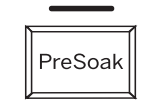 | PreSoak (on some models) For soaking your garments prior to the wash cycle. This option begins with a brief tumble and then proceeds to soak the clothes with water and detergent for a specified period of time. Once complete, the cycle will begin automatically. PreSoak must be selected prior to pressing Start. | The PreSoak time will add an additional 30 minutes to the overall wash time. High-efficiency detergent from the main wash compartment in the dispenser is used for the PreSoak period and main wash cycle. |
10.
 | Time Saver (on some models) Use this option to reduce the overall wash cycle by at least 20% without sacrificing wash performance. This feature is available on all cycles except Tub Clean, Sanitize, Rinse + Spin, and Quick Wash. This option will modify the wash cycle, slightly raising the wash temperature and using more water to deliver equal wash performance as the basic cycle. All other features, such as Extra Rinse, Add Steam, etc, can be used with Time Saver but may adjust the total wash time. | To use:
|
11.
 | Delay Wash You can delay the start of a wash cycle for up to 24 hours. Press the Delay Wash button to choose the amount of time you want to delay the start of the wash cycle. Once the desired time is reached, press the Start button. The machine will count down and start automatically at the correct time. | NOTE: If you forget to fully close the door, a reminder signal will beep reminding you to do so. NOTE: If you open the door when the delay is counting down, the machine will enter the pause state. You must close the door and press Start again in order to restart the countdown. |
12.
 | Extra Rinse This option allows for an extra rinse during a cycle to remove excess dirt and detergent from soiled loads. | On models with Rinse + Spin cycle, a drain and spin cycle can be achieved by pressing the Extra Rinse button until the light is no longer illuminated. |
13.
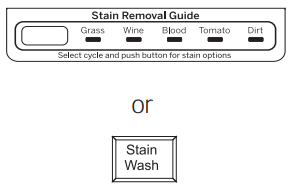 | Stain Removal Guide (on some models) The Stain Removal Guide is preprogrammed with the ideal wash and rinse settings to tackle five common stains. To use this feature, select the desired wash cycle and then press the Stain Removal Guide button until the stain you want to remove is highlighted. Next, press the Start button. For some stains, a prewash will be selected automatically. If desired, add detergent or wash additive to the prewash dispenser. Add Steam cannot be selected along with this feature. | Stain Wash on some models) The Stain Wash modifier can be used with all cycles except Rinse + Spin and Tub Clean and is preprogrammed with the ideal wash and rinse settings to tackle common stains. To use this feature, select the desired wash cycle and then press the Stain Wash button. Once selected, press the Start button to start the cycle. For some stains, a PreSoak will be selected automatically |
14.
 | Tumble Care or Extended Tumble (on some models) Freshly tumbles your garments periodically for up to 8 hours after the wash cycle is complete to lessen the setting of wrinkles and creases when you are not able to move clothing to the dryer right away | At the end of the cycle, the display will scroll “END” and after ten minutes the Tumble Care or Extended Tumble will begin. It can be stopped at any time by pressing the Power button. Note: The Tumble Care or Extended Tumble option cannot be added to the My Cycle feature. |
15.
 | Volume (on some models) This button has two functions:
|
|
16.
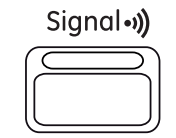 | Cycle Signal (on some models) Use the Signal pad to change the volume of the end of cycle signal. | Press the pad until you reach the desired volume. |
17.
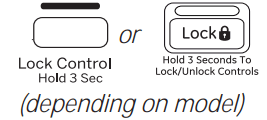 | Lock Controls or Lock (depending on model) You can lock the controls to prevent any selections from being made. Or you can lock or unlock the controls after you have started a cycle. Children cannot accidentally start the washer by touching buttons with this option selected. To lock the washer, press and hold the Lock Controls or Lock button for 3 seconds. | To unlock the washer controls, press and hold the Lock Controls or Lock button for 3 seconds. A sound is made to indicate the lock/ unlock status. The indicator light above the button will illuminate when the controls are locked. NOTE: The Power button can still be used when the machine is locked. |
18.
 | Display Displays the approximate time remaining until the end of the cycle. NOTE: The cycle time is affected by the water pressure in your home and the balance of the load in the washer. You may see the time remaining on the display increase to accommodate a slower spin speed to handle unbalanced loads. On some models, cycle status is also displayed and certain features such as Delay Wash or Steam are shown indicating they have been selected. | If an out-of-balance condition is detected by the washer, the Spin light will blink during the remaining portion of the cycle and will stay illuminated for a short time after cycle completion. On some models, there is also a “Load Rebalancing” message displayed. When this occurs, the washer is taking actions to correct the out-of-balance condition and complete the cycle normally. In some cases, the washer may not be able to balance the load and spin up to full speed. If you notice the load is more wet than usual at the end of the cycle, redistribute the load evenly in the wash tub and run a Drain + Spin cycle. |
Care and Cleaning
Exterior
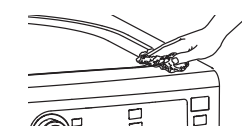 | Immediately wipe off any spills. Wipe with damp cloth. Do not hit surface with sharp objects. |
Interior

To clean the interior of the washer, select the Tub Clean feature on the control panel. This Tub Clean cycle should be performed, at a minimum, once per month. This cycle will use more water, in addition to bleach, to control the rate at which soils and detergents may accumulate in your washer.
NOTE: Read the instructions below completely before starting the Tub Clean cycle.
- Remove any garments or objects from the washer and ensure the washer tub is empty.
- Open the washer door and pour one cup or 250 ml of liquid bleach or other washing machine cleaner into the tub.
- Close the door and select the Tub Clean cycle. Push the Start pad.
- When the Tub Clean cycle is working, the display will show the estimated cycle time remaining. The cycle will complete in about 90 minutes. Do not interrupt the cycle.
- After the cycle is complete, leave the door open slightly for better ventilation.
If for any reason the cycle needs to be interrupted, the door will not open immediately. Forcing open the door at this stage may cause water to flood. The door will open after the water is drained to a level where it would not flood the floor.
Tub Clean may be interrupted by pressing the Start pad in between cycles. A power outage in the house might also interrupt the cycle. When the power supply is back, the Tub Clean cycle resumes where it had stopped. When interrupted, be sure to run a complete Tub Clean cycle before using the washer. If the Power pad is pressed during Tub Clean, the cycle will be lost.
IMPORTANT:
- Run Tub Clean with 1 Cup (250 ml) of bleach once a month.
- After the completion of a Tub Clean cycle, the interior of your washer may have a bleach smell.
- It is recommended to run a light color load after the Tub Clean cycle.
Cleaning the Pump Filter

Due to the nature of the front-load washer, it is sometimes possible for small articles to pass to the pump. The washer has a filter to capture lost items so they are not dumped to the drain. To retrieve lost items, clean out the pump filter.
1. Using a small flathead screwdriver or coin, open the access door.
2. Place a shallow pan or dish under the pump access door and towels on the floor in front of the washer to protect the floor. It is normal to catch about a quart of water when the filter is removed.
NOTE: If there is water in the tub when the pump filter is cleaned, it will drain out and a larger pan or dish may be necessary.
3. Pull down the pour spout.
4. Turn the pump filter counterclockwise and remove the filter slowly, controlling the flow of the draining water.
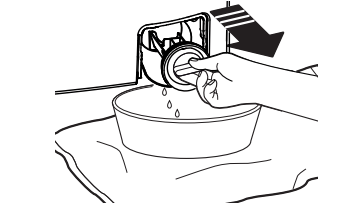
5. Clean the debris from the filter.
6. Replace the filter and turn clockwise. Tighten securely.
7. Flip up the pour spout.
8. Close the access door by hooking the bottom tabs first, then rotating the access door shut.
Dispenser Drawer Area
Tab on back right or left depending on model 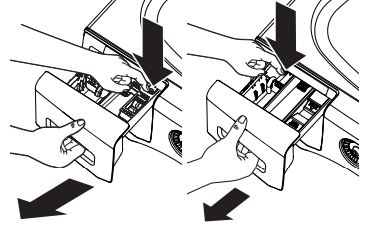 | Detergent and fabric softener may build up in the dispenser drawer. Residue should be removed once or twice a month.
|
Lock tab is visible only after drawer has been pulled open 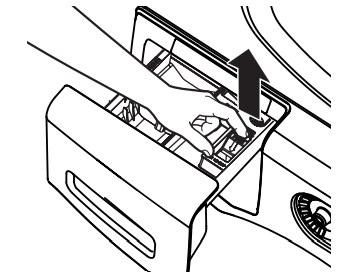 |
|
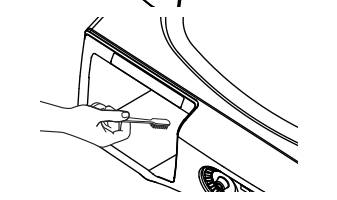 |
 |
Door Gasket
 | Open the washer door. Using both hands, press down the door gasket. Remove any foreign objects if found trapped inside the gasket. Make sure there is nothing blocking the holes behind the gasket. While holding down the door gasket, inspect the interior gasket by pulling it down with your fingers. Remove any foreign objects if found trapped inside this gasket. Make sure there is nothing blocking the holes behind the gasket. When you are finished cleaning the door gasket, remove your hands and the gasket will return to the operating position.  |
Long Vacations
Be sure the water supply is shut off at the faucets. Drain all water from the hoses if the weather will be below freezing.
Moving and Storage
Ask the service technician to remove water from drain pump and hoses. Do not store the washer where it will be exposed to the weather. When moving the washer, the tub should be kept stationary by reinstalling the shipping bolts removed during installation. See Installation Instructions in this book. If these parts are not available, they can be ordered by visiting our Website at GEAppliances website or by calling 800.GE.CARES. In Canada, call 800.561.3344.
Troubleshooting Tips
Truth or myth?
| Truth or Myth? | Answer | Explanation |
| There is not enough water to properly wash my clothes | MYTH | Since frontload washers do not require the tub to fill with water, significantly less water is required to thoroughly wash and rinse each load. Except for certain cycles like Delicates/Handwash and Tub Clean that use more water, you will not see a visible water line on the door glass. |
| My frontload washer may add time or run longer than the original displayed time. | TRUE | Occasionally, the washer may need to add more time to the cycle. This is mainly due to automatic load redistributions to better balance the load and reduce vibration. It is normal operation for the washer to add time to the cycle to rebalance the load. Common causes of out-of-balance loads or longer cycle times are a clogged pump filter (see the Care and Cleaning section), un-level washer, or exceeding the recommended maximum load sizes. |
| I should see suds/foam during a wash cycle in the frontload washer. | MYTH | HE detergents, which should be the only detergents used in your GE Appliances frontload washer, have been formulated to clean effectively without causing a build-up of suds. If you add detergent until a visible suds/foam level is reached, you may be using too much detergent and negatively impacting washer performance. Remember, more suds/foam does not equal more cleaning power. Follow the manufacturer's directions for HE detergent.  |
| It is best to wash full loads and like fabrics together. | TRUE | Wash multiple similar garments at one time for best results. Washing single items can cause an out-of-balance condition. |
| I need to keep the washer level for proper operation and to reduce vibration. | TRUE | If the washer is uneven, adjust the leveling legs so that they are firmly touching the floor and the lock nuts are securely tightened. This is especially important if the washer is installed on a pedestal. Leveling the legs on the washer or the pedestal require the same steps. |
| It is impossible to overload a frontload washer. | MYTH | Although the capacity of the frontload washer allows for larger loads than a traditional topload washer, care must be taken to not overload the wash tub. See the Loading the Washer section for recommended maximum load sizes. Overloading the washer can lead to reduced wash performance and clothes becoming trapped between the door glass and the gasket, possibly causing damage to your gasket or your clothes. |
| If not periodically cleaned, my wash tub and gasket may not maintain a fresh smell. | TRUE | This is true for all washers, not just frontload. Regularly run a Tub Clean cycle and clean around the rubber door gasket. When not in use, you may leave the door slightly open for the inside of the washer to air dry. Close supervision is necessary if this appliance is used by or near children. |
Frontload washers have a "pump filter” that needs to be cleaned periodically. | TRUE | Due to the nature of the frontload washer, it is sometimes possible for small articles to pass to the drain pump. The washer has a filter to capture lost items so they do not damage the drain pump. To retrieve lost items, clean out the pumpfilterfsee the Care and Cleaning section). Indicators of a clogged pump are long drain and cycle times, wet clothes at the end of a cycle, incomplete cycles or washer pausing in the middle of a cycle. |
| I cannot add items to a wash cycle once it has started. | MYTH | To add items after the washer has started, press Start/Pause - Add a Garment button and wait until the door is unlocked. The drain pump may run briefly before door is unlocked. Do not try to force open the door when it is locked. After the door unlocks, open gently. Add items, close the door and press Start/Pause to restart. |
| Items left in pockets can cause damage to the rubber door gasket | TRUE | This is true for all frontload washers. Remove all loose items from your clothes. |
Troubleshooting Tips
| Problem | Possible Cause | What To Do |
Not draining Not spinning Not tumbling | Load is out of balance | Redistribute clothes and run Drain + Spin or Rinse + Spin. Increase load size if washing small load containing heavy and light items. |
| Pump clogged | See page 12 on how to clean the Pump Filter. | |
| Drain hose is kinked or improperly connected | Straighten drain hose and make sure washer is not sitting on it. | |
| Household drain may be clogged | Check household plumbing. You may need to call a plumber. | |
| Drain hose siphoning; drain hose pushed too far down the drain | Ensure there is an air gap between hose and drain. | |
| Leaking water | Door gasket is damaged | Check to see if gasket is seated and not torn. Objects left in pockets may cause damage to the washer (nails, screws, pens, pencils) Water may drip from the door when the door is opened. This is a normal operation. Carefully wipe off rubber door seal. Sometimes dirt or clothing is left in this seal and can cause a small leak |
| Check back left of washer for water | If this area is wet, you have oversudsing condition. Use less detergent. | |
| Fill hoses or drain hose is improperly connected | Make sure hose connections are tight at washer and faucets and make sure end of drain hose is correctly inserted in and secured to drain facility. | |
| Household drain may be clogged | Check household plumbing. You may need to call a plumber. | |
| Dispenser clogged | Powder soap may cause clogs inside the dispenser and cause water to leak out the front of the dispenser. Remove drawer and clean both drawer and inside of dispenser box. Please refer to Cleaning the Washer section. | |
| Incorrect use of detergent | Use only HE and correct amount of detergent. | |
| Dispenser box cracked | If new installation, check for crack on inside of dispenser box. | |
| Clothes too wet | Load is out of balance | Redistribute clothes and run Drain + Spin or Rinse + Spin. Increase load size if washing small load containing heavy and light items. The machine will slow the spin speed down to 410 rpm if it has a hard time balancing the load. This speed is normal. |
| Pump clogged | See page 12 on how to clean the Pump Filter. | |
| Overloading | The dry weight of the load should be less then 16 lbs. | |
| Drain hose is kinked or improperly connected | Straighten drain hose and make sure washer is not sitting on it. | |
| Household drain may be clogged | Check household plumbing. You may need to call a plumber. | |
| Drain hose siphoning; drain hose pushed too far down the drain | Ensure there is an air gap between hose and drain. | |
| Incomplete cycle or timer not advancing | Automatic load redistribution | Timer adds 3 minutes to cycle for each rebalance. 11 or 15 rebalances may be done. This is normal operation. Do nothing; the machine will finish the wash cycle. |
| Pump clogged | See page 12 on how to clean the Pump Filter. | |
| Drain hose is kinked or improperly connected | Straighten drain hose and make sure washer is not sitting on it | |
| Household drain may be clogged | Check household plumbing. You may need to call a plumber. | |
| Drain hose siphoning; drain hose pushed too far down the drain | Ensure there is an air gap between hose and drain. | |
| Loud or unusual noise; vibration or shaking | Cabinet moving | Washer is designed to move 1/4” to reduce forces transmitted to the floor. This movement is normal. |
| All rubber leveling legs are not firmly touching the floor | Push and pull on the back right and then back left of your washer to check if it is level. If the washer is uneven, adjust the rubber leveling legs so they are all firmly touching the floor and locked in place. Your installer should correct this problem. | |
| Unbalanced load | Pause unit, open door and manually redistribute load. To check machine, run rinse and spin with no load. If normal, unbalance was caused by load. | |
| Pump clogged | See page 12 on how to clean the Pump Filter. | |
| No power/washer not working or dead | Washer is unplugged | Make sure cord is plugged securely into a working outlet. |
| Water supply is turned off | Turn both hot and cold faucets fully on. | |
| Circuit breaker/fuse is tripped/ blown | Check house circuit breakers/fuses. Replace fuses or reset breaker. Washer should have separate outlet. | |
| Automatic self system checks | First time the washer is plugged in, automatic checks occur. It may take up to 20 seconds before you can use your washer. This is normal operation. | |
| Snags, holes, tears, rips or excessive wear | Overloaded | Do not exceed maximum recommended load sizes. See recommended maximum load sizes on page 11. |
| Pens, pencils, nails, screws or other objects left in pockets | Remove loose items from pockets. | |
| Pins, snaps, hooks, sharp buttons, belt buckles, zippers and sharp objects left in pockets | Fasten snaps, hooks, buttons and zippers. | |
| Control time wrong or changes | This is normal | During spin the washer may need to rebalance the load sometimes to reduce vibrations. When this happens, the estimated time is increased causing time left to increase or jump. |
| Not enough water | This is normal | Horizontal washers do not require the tub to fill with water like top-load washers. |
| Washer pauses or has to be restarted, or washer door is locked and will not open | Pump clogged | See page 12 on how to clean the Pump Filter. |
| Door unlocks or press Start and machine doesn’t operate | This is normal | Front-load washers start up differently than top-load washers, and it takes 30 seconds to check the system. The door will lock and unlock. |
| Incorrect operation | Simply open and close the door firmly; then press Start. | |
| Water does not enter washer or enters slowly | Automatic self system checks | After Start is pressed, the washer does several system checks. Water will flow 60 seconds after Start is pressed. |
| Water supply is turned off | Turn on both hot and cold faucets fully. | |
| Water valve screens are stopped up | Turn off the water source and remove the water connection hoses from the upper back of the washer. Use a brush or toothpick to clean the screens in the machine. Reconnect the hoses and turn the water back on. | |
| inlet hose screen washers are stopped up | Turn off the water source and remove the inlet hoses from the wall faucets. Use a brush or toothpick to clean the screen washers in the end of the hoses. Reconnect the hoses and turn the water back on. | |
| Wrinkling | Improper sorting | Avoid mixing heavy items (like work clothes) with light items (like blouses) |
| Overloading | Load your washer so clothes have enough room to move freely. | |
| Incorrect wash cycle | Match cycle selection to the type of fabric you arewashing (especially for easy care loads) | |
| Repeated washing in water that is too hot | Wash in warm or cold water. | |
| Grayed or yellowed clothes | Not enough detergent | Use correct amount of detergent. |
| Not using HE (high efficiency) detergent | Use only HE detergent. | |
| Hard water | Use hottest water safe for fabric. Use a water conditioner like Calgon brand or install a water softener. | |
| Water is not hot enough | Make sure water heater is delivering water at 120°–140°F (48°–60°C). | |
| Detergent is not dissolving | Try a liquid HE detergent. | |
| Dye transfer | Sort clothes by color. If fabric label states wash separately, unstable dyes may be indicated. | |
| Colored spots | Incorrect use of fabric softener | Check fabric softener package for instructions and follow directions for using dispenser. |
| Dye transfer | Sort whites or lightly colored items from dark colors. Promptly remove wash load from washer. | |
| Water temperature is incorrect | Water supply is improperly connected | Make sure hoses are connected to correct faucets. |
| House water heater is not set properly | Make sure house water heater is delivering water at 120°–140°F (48°–60°C). | |
| Slight variation in metallic color | This is normal | Due to the metallic properties of paint used for this unique product, slight variations of color may occur due to viewing angles and lighting conditions. |
| Bad odor inside your Washer | Washer unused for a long time, not using recommended quality of HE detergent or used too much detergent | Run a Tub Clean cycle. In case of strong odor, you may need to run the Tub Clean cycle more than once. Use only the amount of detergent recommended on the detergent container Use only HE (high efficiency) detergent. Always remove wet items from the washer promptly after machine stops running. Leave the door slightly open for the water to air dry. Close supervision is necessary if this appliance is used by or near children. Do not allow children to play on or in this or any other appliance. |
| Detergent leak | Incorrect placement of detergent insert | Make sure detergent insert is properly located and fully seated. Never put detergent above max line. |
| This is normal | It is normal operation to see detergent leak on door gasket about 20 seconds after filling the dispenser. | |
| Improper dispensing of softener or bleach | Dispenser clogged | Monthly clean the dispenser drawer to remove buildup of chemicals. |
| Softener or bleach is filled above the max line | Make sure to have the correct amount of softener or bleach. | |
| Softener or bleach cap issue | Make sure softener and bleach cap for dispenser are seated or they will not work. | |
| Dispenser drawer not dispensing properly | Laundry detergent packet placed in dispenser drawer | Laundry detergent packets should not be used in the dispenser. They should only be added directly to the wash tub following the manufacturer's directions. |
| Pump running while washer is not in use | Clog in sump drain | This is normal. Drain sump is detecting an undesired water fill level from a potential open faucet. Shut off water valve and inspect water valve for blockage. |
See other models: GSS25QFMCCC GDT580SMF0ES PSC23SHNABS GLD7708V00BB PGS968SEM1SS
